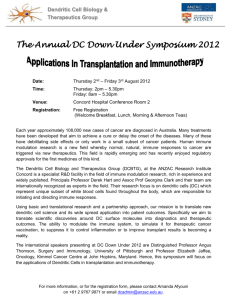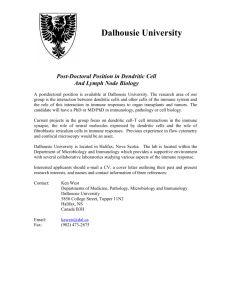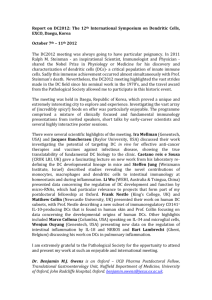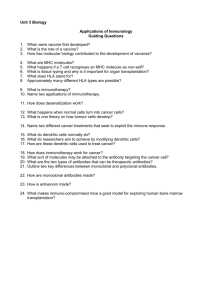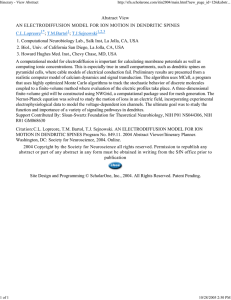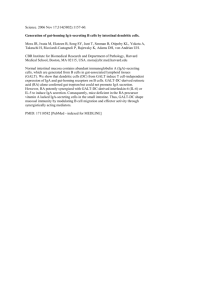What are dendritic cells? Dendritic cells:Ninja of the Immune System
advertisement
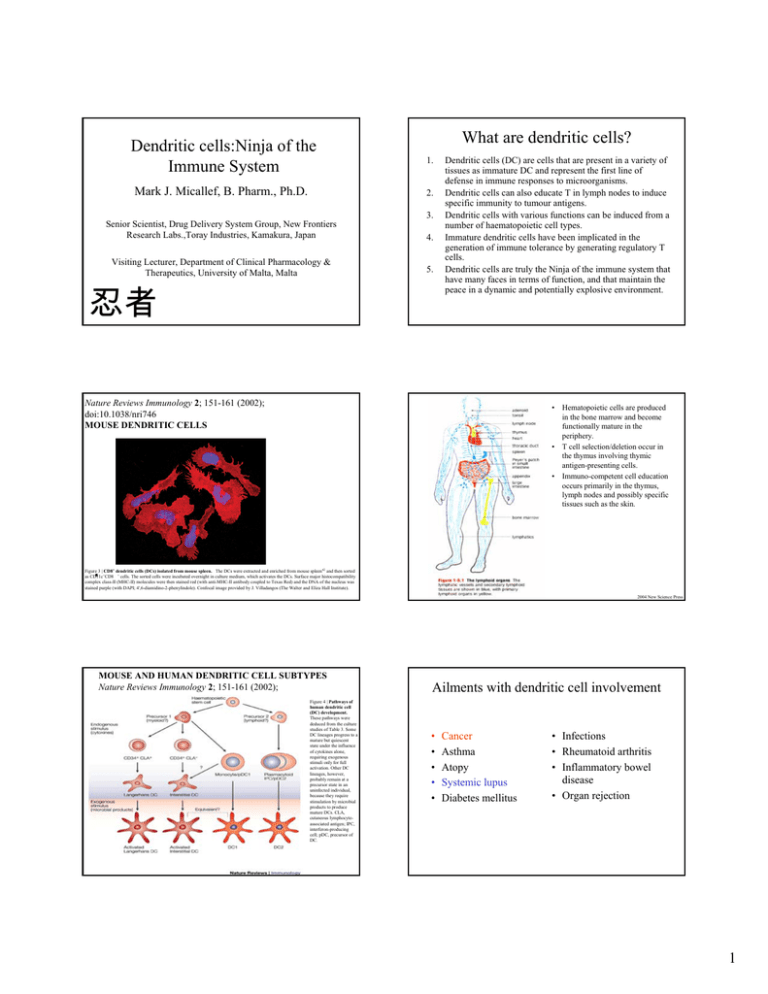
What are dendritic cells? Dendritic cells:Ninja of the Immune System 1. Mark J. Micallef, B. Pharm., Ph.D. 2. 3. Senior Scientist, Drug Delivery System Group, New Frontiers Research Labs.,Toray Industries, Kamakura, Japan 4. Visiting Lecturer, Department of Clinical Pharmacology & Therapeutics, University of Malta, Malta 5. 忍者 Dendritic cells (DC) are cells that are present in a variety of tissues as immature DC and represent the first line of defense in immune responses to microorganisms. Dendritic cells can also educate T in lymph nodes to induce specific immunity to tumour antigens. Dendritic cells with various functions can be induced from a number of haematopoietic cell types. Immature dendritic cells have been implicated in the generation of immune tolerance by generating regulatory T cells. Dendritic cells are truly the Ninja of the immune system that have many faces in terms of function, and that maintain the peace in a dynamic and potentially explosive environment. Nature Reviews Immunology 2; 151-161 (2002); doi:10.1038/nri746 MOUSE DENDRITIC CELLS • Hematopoietic cells are produced in the bone marrow and become functionally mature in the periphery. • T cell selection/deletion occur in the thymus involving thymic antigen-presenting cells. • Immuno-competent cell education occurs primarily in the thymus, lymph nodes and possibly specific tissues such as the skin. Figure 3 | CD8+ dendritic cells (DCs) isolated from mouse spleen. The DCs were extracted and enriched from mouse spleen42 and then sorted as CD11c+CD8 + cells. The sorted cells were incubated overnight in culture medium, which activates the DCs. Surface major histocompatibility complex class-II (MHC-II) molecules were then stained red (with anti-MHC-II antibody coupled to Texas Red) and the DNA of the nucleus was stained purple (with DAPI; 4',6-diamidino-2-phenylindole). Confocal image provided by J. Villadangos (The Walter and Eliza Hall Institute). 2004 New Science Press MOUSE AND HUMAN DENDRITIC CELL SUBTYPES Nature Reviews Immunology 2; 151-161 (2002); Figure 4 | Pathways of human dendritic cell (DC) development. These pathways were deduced from the culture studies of Table 3. Some DC lineages progress to a mature but quiescent state under the influence of cytokines alone, requiring exogenous stimuli only for full activation. Other DC lineages, however, probably remain at a precursor state in an uninfected individual, because they require stimulation by microbial products to produce mature DCs. CLA, cutaneous lymphocyteassociated antigen; IPC, interferon-producing cell; pDC, precursor of DC. Ailments with dendritic cell involvement • • • • • Cancer Asthma Atopy Systemic lupus Diabetes mellitus • Infections • Rheumatoid arthritis • Inflammatory bowel disease • Organ rejection 1 Tumour peptide 9a.a. T cell receptor CD4 molecule HLA class II Tumour peptide 15a.a. Dead/dying tumour cell DC HLA class II Tumour peptide 9a.a. CD8 molecule CD4+ helper T cell Tumour antigen presented on Class I molecule HLA class I T cell receptor Interleukin-2 & interferon-γ Granzyme/perforin Tumour peptide 15a.a. Interleukin-12 & interferon-γ Cell death CD8+ killer T cell Tumour cell Interleukin-2 expands T cell numbers while interleukin-12 and interferon-γ activate/stimulate killer T cells Cytokine-dependent in vitro DC culture and maturation Difficulties with dendritic cell-based cancer immuno-therapies 1. Dendritic cells are too few in number in the peripheral blood and tissues. 2. Some types of dendritic cells can induce immune tolerance to self antigens. Dendritic cells within tumour tissues have been implicated in immunosuppression. 3. Dendritic cells must be activated to exert a stimulatory function on T cells. Interferon-γ Re-infusion of activated mature DC into patient + cancer vaccine General protocol for the generation of monocyte-derived dendritic cells PBMC obtained by fractionation Aphaeresis or Direct administration of DC-stimulatory/activating agents Cancer patient Culture of adherent and loosely-adherent cells. GM-CSF + IL-4 6 days Monocyte-derived DC cultures Myeloid dendritic cells from peripheral blood Identification and selection of dendritic cell types 1. DC may be identified by staining for cell surface molecules that are restricted mainly to DC using mouse antibodies and analysis by flow cytometer. 2. Mature versus immature DC may be identified only functionally. 3. DC may be selected by cell sorting via flow cytometer or AutoMacs after staining with appropriate antibodies. 2 IPC and DC were isolated from human blood by MACS and analysis by flow cytometry. IPC Markers Found on IPC In the human they are CD4+CD11c lineage marker MHC II+ (1). In the mouse they are CD8alpha+ (CD11b(lo), CD11c+, MHC II+ (2). Activation of dendritic cells through receptors for pathogen-associated molecular patterns (PAMPS) 1. DCs may be activated through receptors for PAMPs that are mainly bacterial, fungal and viral products. 2. These receptors are conserved throughout nature and are members of the Toll-like receptor (TLR) family first identified in Drosophila. 3. Some of these receptors are cell surface receptors while others are intracellular proteins. Toll-like Receptors Triacylated lipoprotein Diacylated lipoprotein Imidazoquinolones & single strand RNA flagellin ? CpG DNA dsRNA LPS ? MD-2 TLR1 TLR2 TLR8 TLR5 TLR6 TLR2 TLR7 TLR10 TLR4 TLR9 TLR3 Markers of dendritic cell activation 1. Cytokines are produced by activated DCs dependent upon what TLR is activated. 2. Activated DCs express increased levels of cell surface marker proteins associated with DC function such as MHC class II molecules and CD86, an accessory molecule. 3. Endocytosis of particulate matter such as bacteria or inert material by DCs is also a marker of activated cells. Kadowaki et al., J. Exp. Med., 2001 3 Kadowaki et al., J. Exp. Med., 2001 Analysis of cell surface marker expression by flow cytometer Unstained cells Cells stained with FITCConjugated anti-CD86 antibody Endocytosis of particulate matter by dendritic cells DCs maintained At 4oC DCs maintained At 37oC DC association with disease • Autoimmune-prone NOD mice have large numbers of DC progenitors. • Age reduces the number of DC in the peripheral blood and may be partly responsible for agerelated decrease in immune function. • Airway myeloid DCs are responsible for inducing Th 2 type responses in the induction but not reactivation of asthma in mice. Plasmacytoid DC inhibit reactions to harmless inhaled antigen. • Dendritic cells are accumulated in the mucosal tissues of patients with Crohn’s disease and produce the Th 1 cytokine IL-18. Plasmacytoid dendritic cells • Plasmacytoid DC are found in great numbers in tumours and are thought to induce local immune tolerance to inhibit anti-tumour immune responses. • Plasmacytoid DC produce very large amounts of IFN-α upon stimulation with viral products such as viral RNA and are the source of the IFN-α observed in the sera of patients with SLE. • Both myeloid DC and plasmacytoid DC numbers are reduced in the peripheral blood of pregnant women. • Plasmacytoid DC accumulate in malignant ovarian tumour ascites and are thought to induce immune suppression by producing IL-10. Generation of the main dendritic cell sub-sets Cell surface markers Harvested cell numbers Blood adherent cells* IL-4, GM-CSF monocyte-derived Lin- HLA-DR+ CD4+ CD11c+ CD123dim TLR9- 1 x 108 Blood CD34+ cells * TNF-α, GMCSF+FLT3L Lin- HLA-DR+ CD4+ CD11c+ CD123dim TLR9- Blood CD34+ cells IL-3 Lin- HLA-DR+ CD4+ CD11c- CD123bright TLR9+ Blood CD11c+ cells * None Lin- HLA-DR+ CD4+ CD11c+ CD123dim TLR9- Blood CD123+ cells IL-3 Lin- HLA-DR+ CD4+ CD11c- CD123bright TLR9+ Umbilical cord langerhans cells * * None CD1a+ HLA-DR+ CD11c+ CD80+ Source Inducing factors 5 x 106 3.5 x 106 * ex-vivo pre-clinical/clinical application, **MatTek Corp. 4 Conclusions • The diverse functions of dendritic cells are important in the maintenance of immunological balance in healthy individuals and in the generation of immune responses to microbial infection. • The many phenotypic faces of these antigenpresenting cells, their ability to migrate to lymph nodes and instruct T cells to eventually induce lethal immunological responses make them prime candidates for the title of Ninja of the Immune System 5
